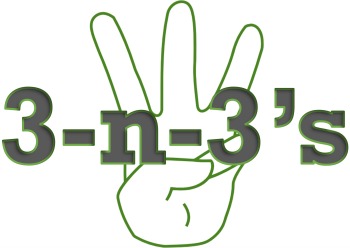 KYLE MEINERT
KYLE MEINERT
Risk Advisor
If you're a leader in your organization, it's 3-n-3 time. No, I'm not talking about a basketball tournament.
What is 3-n-3’s (three and threes)? Also known as Dangers, Opportunities, and Strengths (DOS), 3-n-3's is a powerful exercise you can use to identify strengths, improvements, and business weaknesses in any activity. Think of 3-n-3's as a mini-SWOT analysis (Strengths, Weaknesses, Opportunities, Threats) for any activity in your organization, even if it's an activity you've done a million times. The exercise helps you really nail that task!
3-n-3’s is not writing a simple list. It's a tool to describe the situation. And when you can fully describe the situation, you stand ready to change the game.
The Rules of 3-n-3's: Isolating and Correcting Business Weaknesses
Here's how to perform a 3-n-3's. I recommend you tap your best critical-thinking teammates; 3-n-3's is a team sport:
The first part is describing a task. The task can be anything. Let's use prepping for a client visit as an example.
To start, identify the task: getting ready to visit with a client. Next, record how the task is accomplished, and be as specific as possible. When you prep for a client, you must decide who's invited; set an agenda; ready your meeting materials; and reserve a meeting space. Finally, write down how the task actually was carried out. You'd do this after the client visit occurred. Through these three steps, you completely define the scope of the task.
You're not through yet! Right after the task is done, you'll get into the meat of the 3-n-3’s — where you can make a difference in dollars and cents!
Think about the task you just finished. Jot down, at minimum, three parts of the task that went well and should be repeated the next time the job comes up.
For the client meeting example, let's say the wins were: 1.) The agenda was clear; 2.) The right people were in attendance; and 3.) The meeting materials covered worst-case scenarios, which the client really liked.
Point out these "wins" to your colleagues, and make sure everyone knows these elements now are the expectation.
Remember that 3-n-3's shouldn’t be used to solely isolate bad stuff. This tool helps ID what you did during the mission that ended in a positive result. Don't underestimate the power of getting those achievements down on paper!
Next, you're on to ways to improve. Solicit from your crew a minimum of three parts of the task that could have been better.
For the client visit example, let's say the misses were: 1.) We failed to ask open-ended questions; 2.) There was a missing critical document; and 3.) The snacks/food for the meeting came too late.
Here is the kicker — where 3-n-3’s is much more than a list. With each improvement, there should be a corrective measure assigned. Noting which parts didn't go well without brainstorming a corrective measure completely diminishes the value of 3-n-3’s.
Circling back to the example, here's a look at the shortcoming and its corresponding corrective action:
1.) We failed to ask open-ended questions. | Correction: Ask questions that start with "why," "how," and "what" to encourage deep, explanatory answers.
2.) There was a missing critical document. | Correction: Create a document checklist as a companion piece to the meeting agenda.
3.) The snacks/food for the meeting came too late. | Correction: Place an order the day before (if possible) with a desired delivery time, and keep all meeting rooms well-stocked with snacks and beverages.
Parts of the client visit example may seem trivial, but if you've been in an awkward or bad meeting, you know how some of those "trivial" details (such as food) can affect the mood of a room.
The 3-n-3's exercise can help identify and correct any shortcomings of any task, and your organization only will benefit. [If you'd like another 3-n-3 example, click here. It's a 3-n-3 evaluation of an industrial task — removing a roller from a printing press and cleaning it.]
Get Ready for the Future with 3-n-3's
The 3-n-3’s exercise is designed to prep you for the next time you face the task. If you lazily list the business weaknesses without corresponding corrective measures, you'll still face the same shortcoming in the future and won't have an action plan to overcome it.
You know what the definition of insanity is? Repeating the same action, the same way, over and over, while expecting a different result.
You can see how 3-n-3's breaks the cycle of insanity!
Whatever that corrective measure is, 3-n-3’s is a powerful tool that could be and should be used control risk and to continually improve any task at hand.
Everybody messes up occasionally; it's what you learn from it and do differently next time that really matters. If you don't take time to realize what went well and what needs improvement, you'll face the same insane result.
Leaders should not be afraid to identify business weaknesses. Identifying your weaknesses is how you build structural strength.
Have you tried 3-n-3's, a SWOT analysis, or another tool to strengthen your organization? What's worked for you? What's been a flop? Please share in comments!
Related Posts:
How Getting My Car Stolen Changed My Job
Why Your Employees Need to Understand 'The Why’
Use Data-Driven Strategy to Unravel the Complexity of Your Business
.png?width=69&height=53&name=Acrisure%20Logo%20(White%20Horizontal).png)

 KYLE MEINERT
KYLE MEINERT
